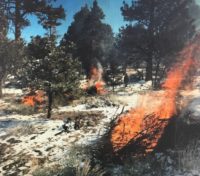
Big Bear News – Big Bear, CA – With the change to winter weather, officials with San Bernardino National Forest are preparing to implement prescribed burning at sites across the Forest, which include the San Bernardino Mountains.
Approximately 2,800 acres are approved for prescribed burning this winter and spring, but not all acres may be accomplished. Fire crews only burn when it is safe and productive. A “burn boss,” the person in charge of a prescribed burn, assesses numerous factors each morning before ignitions can begin. These factors include wind, humidity, air quality, fuel moisture and availability of fire crew personnel. If the criteria are met, creating a so-called “burn window,” crews may move forward with burning.
“We set out each year to accomplish as much prescribed burning as we can, when it is safe to do so,” said Deputy Fire Chief Scott Howes. “We really appreciate the public’s continued support for this important work.”
The potential locations this winter and spring are:
San Bernardino Mountains (Big Bear, Angelus Oaks, Lake Arrowhead)
· Grass Valley, northwest of Lake Arrowhead (pile burn): 382 acres
· City Creek Road (1N09), east of Highway 330 (broadcast burn): 35 acres
· Baldwin Lake, east of Big Bear Lake (pile burn): 600 acres
· Angelus Oaks (broadcast burn): 96 acres
· South Big Bear: (broadcast burn): 262 acres (includes Bluff Mesa; more acreage could be added to this site)
· Various fire stations (pile burn): 77 acres (piles at City Creek Fire Station, off Highway 330, tentatively scheduled for the week of January 4, 2021)
Prescribed burning is an active forest management activity that helps restore ecological functions to the forest. Fire has a natural role in coniferous regions of the San Bernardino National Forest. Caused naturally by lightning, fire has long maintained the health of forests, clearing brush on the forest floor and releasing seeds from pine cones, among other natural processes.
Drought, fuel buildups and fire exclusion—all compounded by climate change and homes spreading into fire-prone landscapes over the past century—have increased the severity of wildfires and allowed fuels to unnaturally build up. That build-up results in an overabundance of flammable brush, which can enable wildfire to quickly spread into the canopy and toward communities and infrastructure. In addition to forest health, prescribed burning allows firefighters to be safely placed between a wildfire and a community or important infrastructure assets, such as fire stations and communications towers.
There are two types of burning that occurs: pile and broadcast. Piles are created for brush clearance around facilities, such as fire stations and communications towers. In other areas, they are created before broadcast burning can safely occur. Vegetation is removed to create spacing and low branches are limbed to limit a wildfire crawling up to a canopy of a tree.
Broadcast burning occurs when firefighters treat an area within a pre-determined boundary, mimicking a low-intensity fire ignited by a lightning strike.
Despite the work done around communities, Forest officials encourage property owners to also do their part by following their local fire abatement regulations for creating defensible space around their structures. Additionally, CAL FIRE has tips for defensible space, home hardening and native plant landscaping at ReadyForWildfire.org.?


